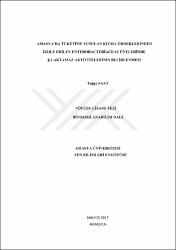Amasya'da tüketime sunulan kıyma örneklerinden izole edilen Enterobacteriaceae üyelerinde ?-laktamaz aktivitelerinin belirlenmesi

View/
xmlui.dri2xhtml.METS-1.0.item-rights
info:eu-repo/semantics/openAccessDate
2017Metadata
Show full item recordAbstract
Antibiyotik dirençliliğinin hayvansal gıdalar aracılığıyla yayılabilme olasılığı yüksektir ve enfeksiyonların tedavisinde başarı oranını azaltmaktadır. ?-laktam antibiyotiklerini hidrolize ederek inaktif hale getiren ?-laktamaz enzim üretimi, başta Enterobacteriaceae üyeleri olmak üzere birçok bakteri türünün önemli direnç mekanizmalarından birisidir. Çalışmamızda, Amasya ilinde tüketime sunulan kıyma örneklerinden elde edilen Enterobacteriaceae izolatlarında ?-laktamaz enziminin ve GSBL tipleri olan TEM, SHV ve CTX-M gen bölgelerinin belirlenmesi amaçlanmıştır. Kıyma örneklerinden 100 adet Enterobacteriaceae izole edilmiştir. ?-laktamaz enziminin varlığı Seftazidim (CAZ), Seftriakson (CRO), Sefotaksim (CTX), Aztreonam (ATM) ve Klavulanik Asit/ Amoksisilin (AMC) antibiyotik diskleri kullanılarak çift disk sinerji yöntemiyle belirlenmiştir. Bu izolatların %68'inin GSBL (+) olduğu bulunmuştur. Suşların antibiyotik direnç profilleri ise disk difüzyon yöntemiyle aztreonam, ampisilin, sefotaksim, seftriakson, kloromfenikol, gentamisin, imipenem, sulfametoksazol, streptomisin ve tetrasiklin antibiyotikleri kullanılarak tespit edilmiştir. Disk difüzyon duyarlılık testi sonuçlarına göre ampisilin, aztreonam, kloromfenikol, sefotaksim, seftriakson, tetrasiklin, gentamisin, imipenem, streptomisin ve sulfametoksazol antibiyotiklerine direnç oranları sırasıyla; %27,94, %2,95, %25,0, %14,70, %4,42, %1,50, %1,50 %10,29, %22,05, %17,70 olarak bulunmuştur. ?-laktamaz pozitif olduğu belirlenen izolatlarda GSBL tipleri olan TEM, SHV ve CTX-M gen bölgeleri varlığı PZR yöntemi uygulanarak doğrulanmıştır. %35,29'unda CTX-M tipi , %23,52'sinde SHV tipi ?-laktamaz varlığına rastlanılırken izolatların hiçbirinde TEM tipi ?-laktamaz varlığına rastlanılmamıştır. Sonuç olarak, antibiyotik kullanımının kontrol altına alınması ile GSBL pozitif izolat sıklığının ve GSBL tiplerinin yayılımının azalması beklenmektedir. It is high the probability of to be spreaded by animal foods of antibiotic resistance and is decreased the success ratio of treatment againts to infections. The production of ?-lactamase enzyme which inactivates antibiotics by hydrolysis is one of the important resistance mechanisms in many bacterial species mainly Enterobacteriaceae members. Our study aimed to identify ?-lactamase enzyme with TEM, SHV and CTX-M gene locations that are ESBL types in Enterobacteriaceae isolates obtained from ground meat presented for consumption in Amasya. We isolated 100 Enterobacteriaceae samples from ground meat. The presence of ?-lactamase enzyme was determined by double-disk synergy test with Ceftazidime (CAZ), Ceftriaxone (CRO), Cefotaxime (CTX), Aztreonam (ATM) and Amoxicillin/clavulanic acid (AMC) antibiotic disks. We found that 68% of all samples were ESBL (+). The antibiotic resistance profiles of strains were also identified by disk diffusion method using aztreonam, ampicillin, cefotaxime, ceftriaxone, chloramphenicol, gentamicin, imipenem, sulfamethoxazole, streptomycin and tetracycline antibiotics. We found that according to disk diffusion test, the the antibiotics resistance rates of ampicillin, aztreonam, chloramphenicol, cefotaxime, ceftriaxone, tetracycline, gentamicin, imipenem, streptomycin and sulfamethoxazole were 27,94%, 2,95%, 25,0%, 14,70%, 4,42%, 1,50%, 1,50%, 10,29%, 22,05%, 17,70%, respectively. The presence of the types of ESBL, TEM, SHV and CTX-M gene locations, in ?-lactamase positive isolates were also confirmed by PCR. There was no presence of TEM-type beta-lactamase in any of the isolates when the presence of CTX-M type at 35,29% and SHV type beta-lactamase at 23,52% were observed. As a result, it is expected that the frequency of ESBL positive isolate and the spread of ESBL type will be reduced by controlling antibiotic usage.
URI
https://tez.yok.gov.tr/UlusalTezMerkezi/TezGoster?key=7lOJX8w_8PRQU1mSHU6-jhuhhV2XKJxqYiD3GVNomwYds-iXUhOdnw8FhxoyDrhBhttps://hdl.handle.net/20.500.12450/1718
Collections
- Tez Koleksiyonu [397]

















